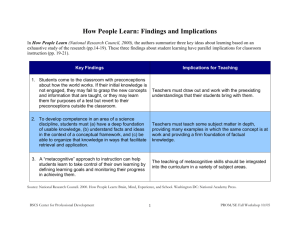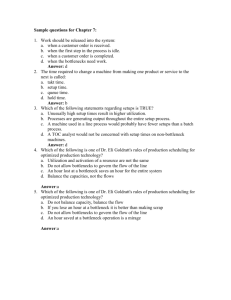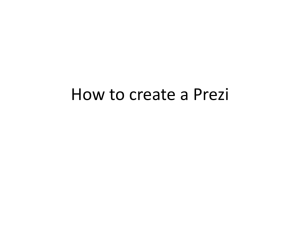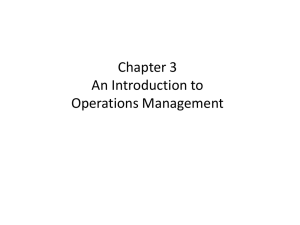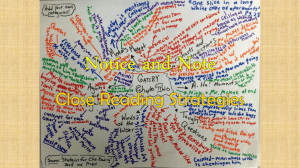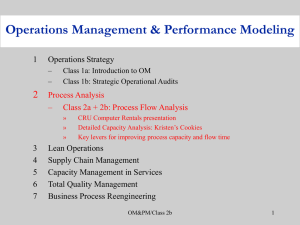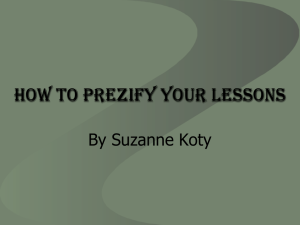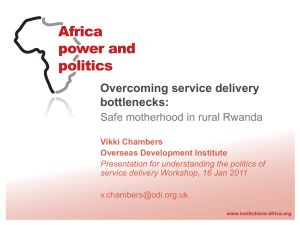Emotions and Learning
advertisement
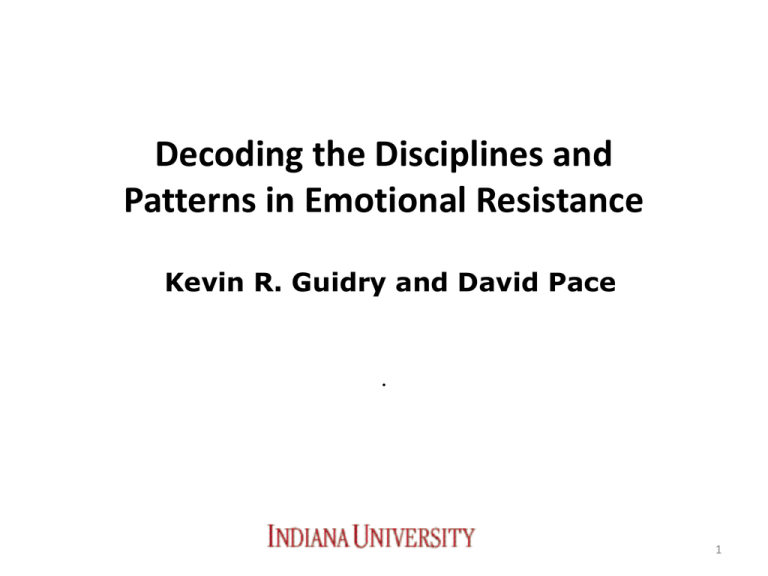
Decoding the Disciplines and Patterns in Emotional Resistance Kevin R. Guidry and David Pace . 1 Paradigm Shift 2 Session Goals I. Learn to anticipate student emotional bottlenecks II. Discuss an affective bottleneck in your class III.Design an assessment for your bottleneck 3 I: Emotional Bottlenecks 4 I. What are emotional bottlenecks? • Emotions are completely intertwined with learning – How you frame something cognitively shapes the emotions you feel about it • Emotional bottlenecks may come from a mismatch between students’ notions of the content and that encountered in the class • They may also arise from a mismatch between students’ image of the discipline and what is actually encountered in the course 5 I: An emotional bottleneck – Reaction to the subject matter 6 I: An emotional bottleneck – Reaction to the nature of the discipline 7 I. Narrative Emotional Bottleneck 8 II. The Emotional Bottleneck in your class What is an emotional bottleneck for the students in one of your courses? And what is the nature of the problem? Think and write (2 minutes) First member of group speaks (2 mins.) Second member of group speaks (2 mins.) Third member of group speaks (2 mins.) 9 II: Your Bottlenecks • What did you learn about each others’ bottlenecks? Were there similarities or differences? 10 Chi on Persistent Misconceptions • To make a conceptual shift: 1.Collect information about student preconceptions—what do they think about the topic before you teach it? 2.Show them the results. 3.Make a side-by-side comparison of their preconceptions and how that is uniquely distinct from the new way of thinking. 4.Now they may begin to assimilate new instruction. Step 6: Assessing Preconceptions Questions to use 1.Besides hard work, what does it take to do well in this course? 2. What happened during X? (the Middle Ages? 3. What have you heard about X? (global warming, calculus) Always add Part II: “Why do you say that?” Handout 3 12 III. Analyze student data Uncovering Student Narratives 13 III. Analyze student data Uncovering Student Narratives 14 III. Analyze student data Power of Metaphors 15 Step 6: How would you assess student preconceptions? Discuss in teams of 3: What question could you ask to uncover the narratives or disciplinary preconceptions students bring to your class? 4 minutes per person 16 Step 6: Assessing Preconceptions Questions to use 1.Besides hard work, what does it take to do well in this course? 2. What happened during X? (the Middle Ages? 3. What have you heard about X? (global warming, calculus) Always add Part II: “Why do you say that?” Handout 3 17 How would you assess student preconceptions? Report back-Will someone share an example? 18 Student preconceptions in History – Bottleneck: Students are unable to see the perspectives of different actors from the past • They look for good guys and bad guys Step 2: Expert Thinking in History • Historians reconstruct the realities of different actors in the past 20 Step 3: Modeling—History e.g. – Gestalt Images – Retelling stories – In-class modeling of reconstruction of the values and assumptions implicit in texts 21 Step 4: Practice and Feedback • Now I was prepared to use Prezi – The learning teams were asked to come up with a short list of issues that were of concern to either of these two thinkers . Aquinas Mandeville Step 4: Practice and Feedback • Now I was prepared to use Prezi – I entered these terms next to both of the names Creature Comforts Protecting the Week Economic Productivity Aquinas Population Increase Protecting the Week The Afterlife Creature Comforts Mandeville Population Increase Virtue The Afterlife Economic Productivity Virtue Step 4: Practice and Feedback • The students then had to tell how big to make each term, as a reflection of its importance in one of the two systems of thought Creature Comforts Protecting the Week Population Increase Economic Productivity Aquinas Virtue The Afterlife Economic MandevilleProductivity Creature Virtue Population Increase Comforts Protecting the Week The Afterlife Step 4: Practice—History e.g. • On-line assignments – Week 4 – Students asked to identify the values implicit in Victorian championing of competition, to identify passages in which these values are present, and to explain what in the passage convinced them of this • Then they have to describe the position of thinkers who did not accept these views of competition – Week 5 – Students asked to find contrasting passages from Marx and Engels and from defender of capitalism Samuel Smiles • Then they have to explain what values were present in each passage 25 Using Prezi to Give Students Practice at Both These Tasks • Each learning team took one of four ways of thinking about conflict and competition in the nineteenth and early twentieth centuries – Classical liberalism – Marxism – Pacifism – Militarism/Fascism Using Prezi to Give Students Practice at Both These Tasks • The task of each team was to use Prezi to represent – The principal ideas of the group of thinkers that they were focusing on – Explain how their group would have dismissed the ideas of other groups Using Prezi to Give Students Practice at Both These Tasks • Goals of the exercise – To reinforce previous exercise – To give the students practice at “playing” with ideas – To motivate student inquiry [Step 6: Motivation] – To assess how well the students were mastering the operations The Experience of the Exercise • Level of student involvement – The power of play and autonomy – The desire to produce something that impressed the other teams – Taking ownership of the technology • Visual • Combining Prezis Lego Action Figures of Marx and Engels The Power of Play Step 6: Assessment—History e.g. Disrupting Ritual Interactions See Handout 2 31 Step 6: Assessment—History e.g. • Pre-Post comparisons – Compare assignments in weeks 4 and 15 – Average score increased from 2.3 to 3.5 (34%) – Scoring scale: 1= repetition of literal meaning 5 = polished presentation of the assumptions implicit in the text Give evidence a number so others can use it easily 32 Step 6: Assessment—History e.g. • Multiple measures: Is there other evidence that students incorporated these ideas into their notions of history? – Week 14 Assignment: Describe a way of analyzing historical sources that you have learned in this course (i.e. what might you do in writing this paper that you would not have thought to do when the course began?) – Videotaped Interviews: Did students specifically describe the use of values and assumptions in discussing what they gained from the course? 33


